NOW UPDATED! This post on creating an effective content marketing strategy to grow your brand has been updated for 2020.
Content marketing is no longer the simple, easy-to-execute tactic it was in the early days of the boom when it was all about blogs and keywords, and “content strategy” was a concept that was yet to be born.
Back in 2010, it was easy to gain a competitive advantage through content marketing, but ten years later, it’s a tactic that few businesses fail to employ. Of course, this means it’s even more important to get it right — companies that don’t, risk falling far behind their rivals.
Content marketing is a method that drives traffic to your site using multimedia content in order to generate leads and build relationships with prospects. Sure, it sounds intimidating, but in 2020 you can’t afford to be getting content marketing wrong.
With that in mind, in this guide, I’m going to break it all down for you. We’ll go through how to use content marketing for your business. We’ll discuss what falls under the umbrella of content marketing, how it works, how to develop a content strategy, tools that will help you out, and much more!
What Is Content Marketing?
As always, let's start with a simple definition!
Content marketing is the practice of providing free (or gated) content to users in order to attract them to your site and prompt them to engage with your brand. Unlike blogging, content marketing is strategic, with specific goals for everything you create.
Different types of content fall under this umbrella, including:
- Blogging, which can happen on your own site (“owned media”) or involve guest blogging for other publications, and can include text, images, infographics and videos
- E-books or white papers, which are often used as lead magnets to capture information like a user’s email address
- Email newsletters, which can build relationships with readers and encourage them to head back to your site
- Webinars and other video content, which can help you convey your brand personality and increase user engagement (especially since video has become very popular)
- Landing pages, which are hosted on your own site and direct users to click a button to find out further information or convert
Dive Deeper:
* A Handy Content Marketing Glossary of Terms
* 22 Brands with the Best Content Marketing Campaigns
* How to Think Like an Investor to Win at Content Marketing in 2020
How Does Content Marketing Work for Inbound Marketing?
Inbound marketing is the practice of attracting customers through engaging, relevant content. In contrast, outbound marketing relies on sales calls, social ads and email campaigns that actively reach out to the customer.
Content marketing is one tactic of inbound marketing, so they go hand in hand. And since about 26% of people now use ad blockers and GDPR restrictions have tightened the hatches on outbound marketing, content marketers have an incredible advantage.
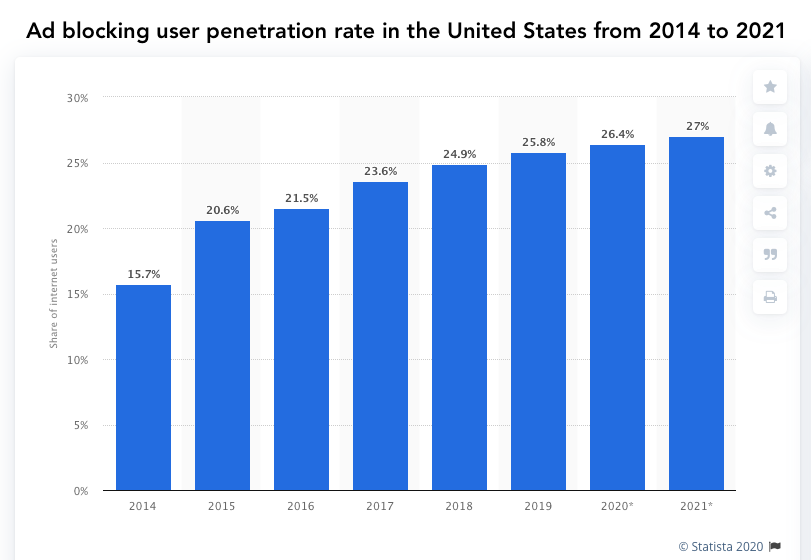
Content marketing brings people to you at various stages of the digital sales funnel and for different reasons. Traffic will come to your site from:
- Organic search when your content is optimized well enough to rank highly
- Organic and paid social posts
- Social posts that have gone viral or been shared on a smaller scale
- Influencers or bloggers whom you have collaborated with to share branded content
Since content marketing is all about drawing your audience in with high-value content, your content must be genuinely engaging, informative and/or entertaining to your audience. Just because it’s something you want to write or shoot doesn’t mean it’s something they want to read or watch.
If you’re wondering why a lot of big businesses have invested heavily in UX (user experience), blogs, e-books, infographics, apps, high-quality video or any other type of content, check out these stats:
- 70% of marketers are actively investing in content marketing.
- Per dollar, content marketing produces 3X more leads than outbound marketing.
- 70% of survey respondents said that SEO is better than PPC for generating sales.
- 55% of marketers say blog content creation is their top inbound marketing priority.
- 86% of marketers say that having a good content strategy is a major key to their success.
- 89% content marketers say that they measure the success of content marketing by increased website traffic.
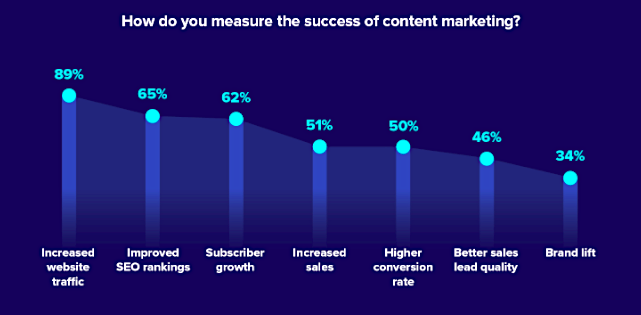
And if all that’s not enough, take a look at a few of these case studies:
- ADP used white papers and a white paper search function to generate $1 million of new sales opportunities within three months.
- A single infographic from Shutterstock got more than 100 mentions, 6 billion unique site visits, 5,300 social media shares, and more than 11,000 social media engagements.
There are a lot more great success stories out there (try a quick Google search!) that show you the power of content marketing. That being said, you’ll only get these results if you execute this type of marketing well.
The first step to developing a successful content marketing strategy is to set your goals.
Dive Deeper:
* What’s the Right Content for Each Stage of the Marketing Funnel?
* 6 Steps to Prove to Your CEO that Inbound Marketing Can Generate ROI
* The Ultimate Guide to Growing Your Business with Influencer Marketing
How to Develop a Content Marketing Strategy
Great content is pretty useless without a strategy behind it, and this is the biggest marketing mistake that brands consistently make.
A successful content strategy is carefully created, documented and executed without deviation. Yet a lot of marketers still don’t have a content strategy at all — or don’t have a documented strategy, believing that a vague idea of where they’re heading will suffice. In this competitive era, it won’t.
Here’s how to create a content marketing strategy that will work.
1) Choose Your Goals
Content marketing can help you accomplish a number of very different goals. The key is to know which goals you’re trying to hit — in other words, what you want your content marketing to actually do.
It goes without saying that for most brands, the ultimate goal will always be to get more customers and more sales. Different strategic goals that you can focus on include:
- Driving immediate sales
- Getting more traffic to your site through social shares or SEO
- Improving the overall SEO of your site with a UX review, optimized content, improved CTAs, backlinks, etc.
- Building brand awareness
- Establishing yourself as an industry expert or thought leader
- Generating new leads
- Increasing the number of email subscribers
- Boosting on-site engagement
Your content marketing strategy can take any or even all of these goals into account, but it’s important to note what exactly you want to accomplish with both your overall strategy and each individual piece of content so that you can optimize for it. It's a good idea to start with one or two goals and then change them or branch out once you've seen some good ROI.
2) Set Your Content Marketing KPIs
Your Key Performance Indicators (KPIs) are the essential metrics that you’ll watch in order to evaluate your progress towards your goals. These need to be specific, measurable metrics that can clearly demonstrate progress.
For example, if boosting lead generation is your number one goal, you’ll likely use a high-value piece of content like an e-book, and stick it behind a data capture form. In order to download the e-book, prospects will need to give you some data — usually name, job title, and email address.
In this case, your KPI could be “number of downloads” of that e-book. Set a realistic target for this metric (say, 100 per month) and if you hit it, you can be confident that your tactic has taken you further towards your overall goal of gathering 100 more leads per month.
Not sure where to start? Try focusing on these KPIs:
- Sales: Number of conversions, which can be tracked in Google Analytics once you set up conversion tracking.
- Site traffic: Number of website visitors (specifically to your blog posts); you can also utilize Google Analytics to see which posts are bringing in the most traffic.
- SEO authority: Your SERP ranking, which can be found and tracked with tools like SEMrush’s position tracking:
![]()
- Brand awareness and thought leadership: Use tools like Mention to track social media mentions of your brand in order to see what people are saying.
- Lead generation and email subscribers: Monitor new lead sign-ups, which can be evaluated by tracking the growth of your email list. Make sure to look at the number of new sign-ups and not just overall total, because some amount of churn is normal.
- On-site engagement: Measure the comments and social shares that happen directly from your post. These are easy to evaluate with no external tools, though social sharing counters like Cresta Social Share Counter can help. Hotjar, meanwhile, can help you see where people are spending their time on your site and which CTAs they’re clicking on:

Dive Deeper: The Only 4 Marketing/Content Marketing KPIs That Really Matter
3) Create Your Content Strategy Document
Rather than just winging it and starting from scratch each time you create a new piece of content, you should document the entire process (and refine it) so that you can simply follow a pre-determined set of steps for the most efficiency.
Here are the major points you'll want to include in this document:
- Do your audience research and create audience segments with specific traits — for example people over the age of 50 or people who live in New England. Note which tools you use for this.
- Hold meetings with key teams or team members to discover the best strategy as well as which business goals are most important. You'll also need to determine how much budget you have to work with.
- Work with creatives (writers, designers, marketers) to come up with engaging campaign concepts that are specifically designed to appeal to your audience (for example, if they're younger, they may prefer video).
- Break down the campaigns into different tactics or content forms — for example four blogs, one video, and 10 social posts. Take a look at this article to learn how to create more content in less time: #1 Marketing Strategy: The Content Sprout Method
- Figure out who is going to produce which piece content (writer, editor, designer, etc.) and according to what timeline.
- Get sign off from key stakeholders, if needed.
- Finally, set up tracking for your campaigns — and you're ready to go!
4) Optimize Your Content
For every single post that you write, infographic that you design or video that you create, you should have one specific goal in mind for it. That makes it much more efficient to optimize the living daylights out of that post.
Plus, it makes it easier for you to give users actions that they can take without their feeling overwhelmed, and thus will increase the effectiveness of the individual post.
Specific actions you can take to optimize posts based on your specific goals include:
- Sales: Mention products in your posts and include a link towards the end of them with a strong call to action (CTA) urging them to go check it out.
- Site traffic: Encourage social sharing, and make sure your content is relevant and full of H2 tags that will help you rank well.
- SEO authority: Link your content to other high-value, high-authority sites.
- Brand awareness and thought leadership: Link to other content that you’ve written, especially on other blogs, to show your array of knowledge, and engage with other thought leaders on social platforms.
- Lead generation and email subscribers: Place CTA buttons throughout the post to encourage email sign-ups, and use an opt-in widget on the side of the post. This can feature a lead magnet like an e-book or white paper if you have one, or even a free consultation. It can be simple:

Or a little more in-depth:
- On-site engagement: Make it easy for users to leave comments on your site. Disqus is a great tool for this, and it’s a plugin that’s particularly good at generating not only comments but actual discussions.
5) Format Your Blog Posts
In addition to these above optimization practices, there are other best practices that you can (and absolutely should) apply to every blog post, including:
- Call to Action: Always, always having a distinct CTA at the end of every post – and, even better, throughout the post.
- CTA Placement: For maximum impact, the CTA button or link should be separated from the last paragraph by at least one space and ideally highlighted, bolded or italicized to draw attention to it. Place a clickable link with specific instructions like “sign up for our e-book here” or “register for our webinar now.” The more actionable and specific your CTA, the better.
- CTA Copy: Your CTA should also be directly relevant to the goal of your post. In the example below from Shakr, the goal is to get more people using a product, and that’s made clear in the CTA:
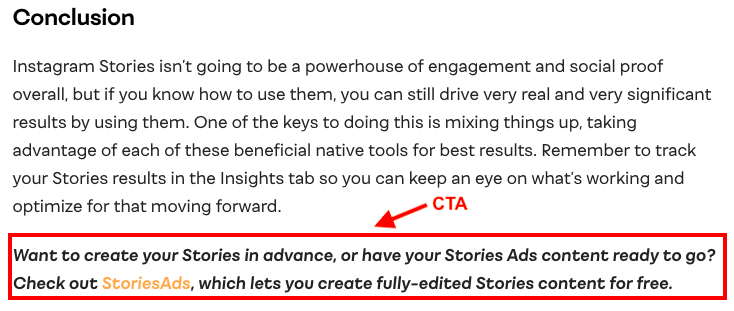
- Social Sharing: Take advantage of social sharing bars, which can be installed through plug-ins and make it super easy for people to share your article – all the reader needs to do is click a button. This will help you distribute your post without any extra effort on your part. Some plug-ins even have social sharing counters, telling other readers how many people have shared, which acts as powerful social proof:

- Click to Tweet: Help people easily share a great quote from your article with click to Tweet options. Not only do they make social sharing a breeze, but since they look a little different from the rest of the text, they’ll stand out and be more actionable. Here's an example (go ahead, click it to Tweet it!):
Content marketing is a great way to attract new customers to your site and build relationships with them in real, quantifiable ways over a period of time.
Click To Tweet
- Sidebar Widgets: In most cases, your content won’t take up the whole screen, so take advantage of that extra space to the right with sidebar widgets that give you more room for email opt-in boxes and places to promote your lead magnet (you can also place these above or below your post):
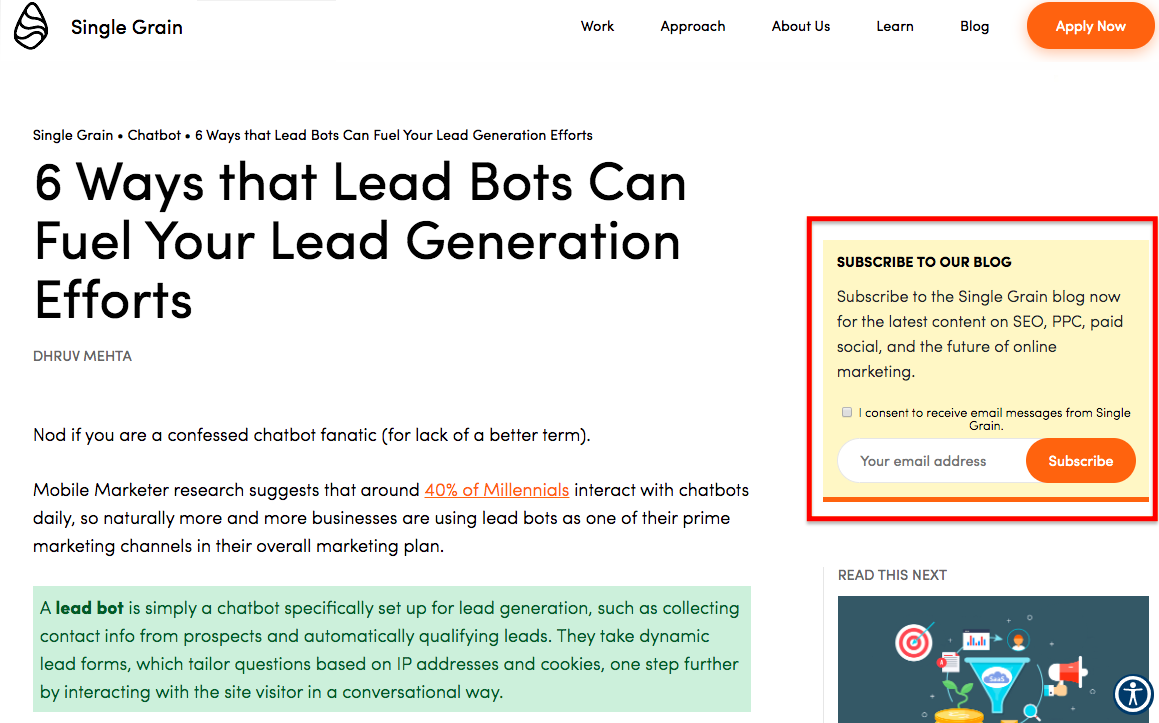
Dive Deeper: How to Write Content for People and Optimize It for Google
6) Measure Your Results
Once your content marketing strategy is up and running and you’re publishing new posts, videos and lead magnets, it’s time to implement the KPI tracking you’ve set up so that you can see how you’re progressing towards your goals.
Keep a close eye on which content is performing best. Do shorter videos get more results than longer ones? Do infographics get more social shares than text-based articles? Do certain types or topics of posts receive more clicks on the CTA?
Google Analytics is your best friend. It’s a free tool that will tell you about everything happening on your site, including where you’re getting your traffic from, which pages they’re entering on, how they’re moving through the site, and how long they’re staying. It’s free and easy to install.
The screenshot below shows the Acquisition section of the tool (in the left-hand column) – a great place to see which medium or source is bringing in the most traffic, how many were new readers (very important!), the highest and lowest bounce rates (low is better), and any conversions you're tracking.
We've set Content Downloads and Free Consultations as two of our Google Analytics goals, and you can see which medium is bringing in visitors who actually convert:

Note: Regarding KPIs — while more traffic is incredibly important, the quality and engagement of that traffic is equally or more so.
For example, if you're bringing in a lot of social traffic, but visitors bounce from your page quickly and/or don't take any action, they're not as qualified as a medium which brings in less traffic, but leads to higher conversion rates. This doesn't mean one medium is better or worse – it could be that your captions on social media are misleading, so people don't stay once they see what your content is actually about.
Look for trends in performance and see if you can find reasons for why some posts, lead magnets or videos do well when others don’t. A/B testing is a huge help here.
When we make any major content changes, we annotate them in Google Analytics and keep a spreadsheet with those actions – seeing if the rank, keyword or traffic alters due to that change.
You should also look at the behavior flow dashboard (under “Behavior” in the left-hand column) to see how people are moving to through your site:
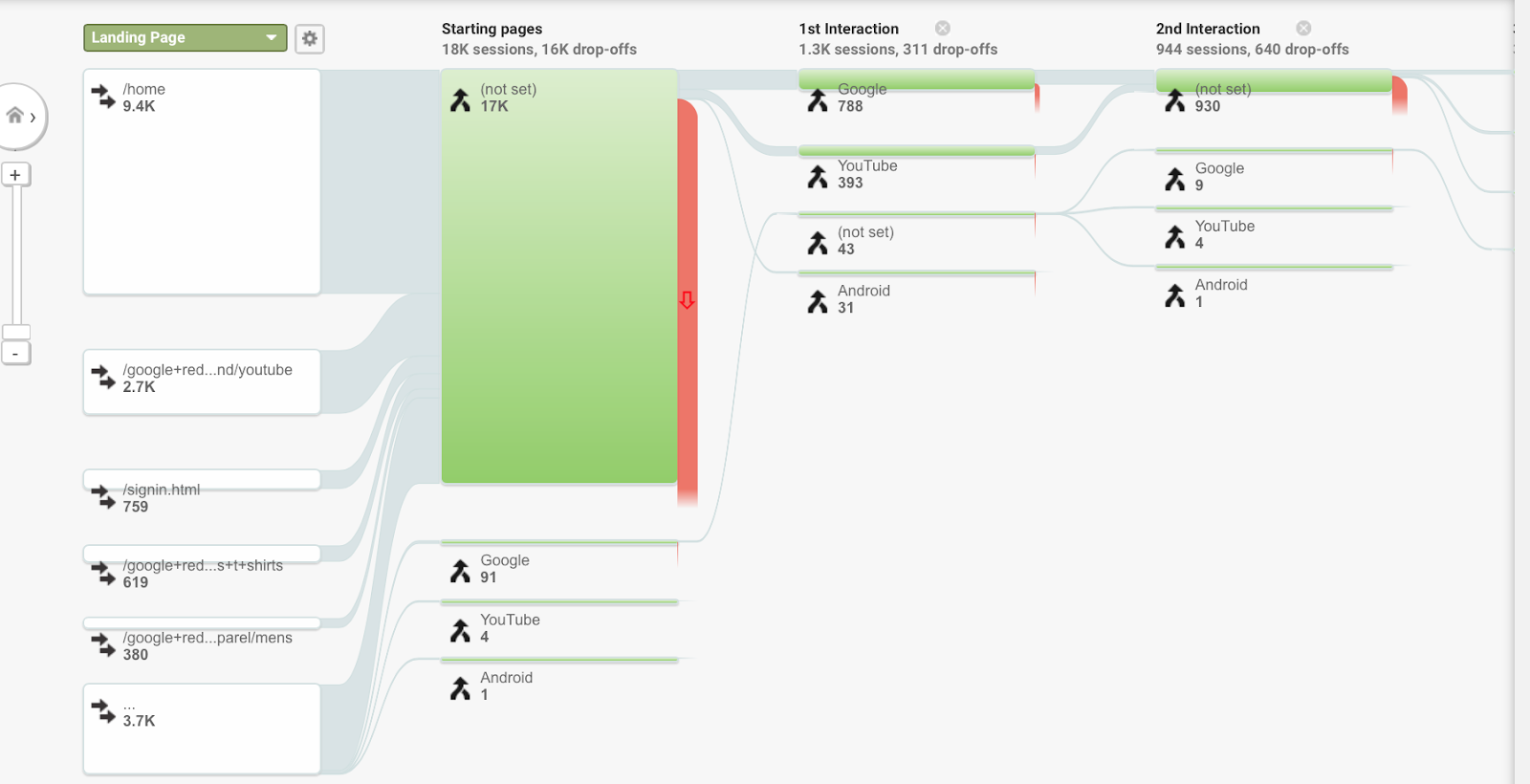
Watch for big drop-off points that stop before or at the lead magnet in order to troubleshoot your funnel.
If users make it through three blog posts but then don’t sign up for a related e-book, you need to figure out why. Is the e-book similar in content to the article? Is it not relevant to the article? Are readers simply not interested in the e-book you're offering? Have you not optimized the landing page to explain the value of the e-book? By solving the disconnect on the landing page, you’ll be able to get more results.
Continue to measure, analyze and adjust your content regularly. Especially with best practices in marketing changing so frequently, you can’t afford not to.
Dive Deeper:
* How To Create CTAs that Actually Cause Action
* The Ultimate Guide to Creating a High-Converting Landing Page in 2020
* Google Analytics for Content Marketing: How to Track and Improve Your ROI
Creating a Lead-Nurturing Funnel
A single blog post or video won’t get you results on its own, even if there’s strategy behind it. Even a lead magnet can only do so much if it isn’t incorporated into a larger plan that works towards a single goal.
That’s what a funnel is for. A lead-nurturing funnel works by using multiple touch points to attract readers and push them into different stages of the digital buyer’s journey:
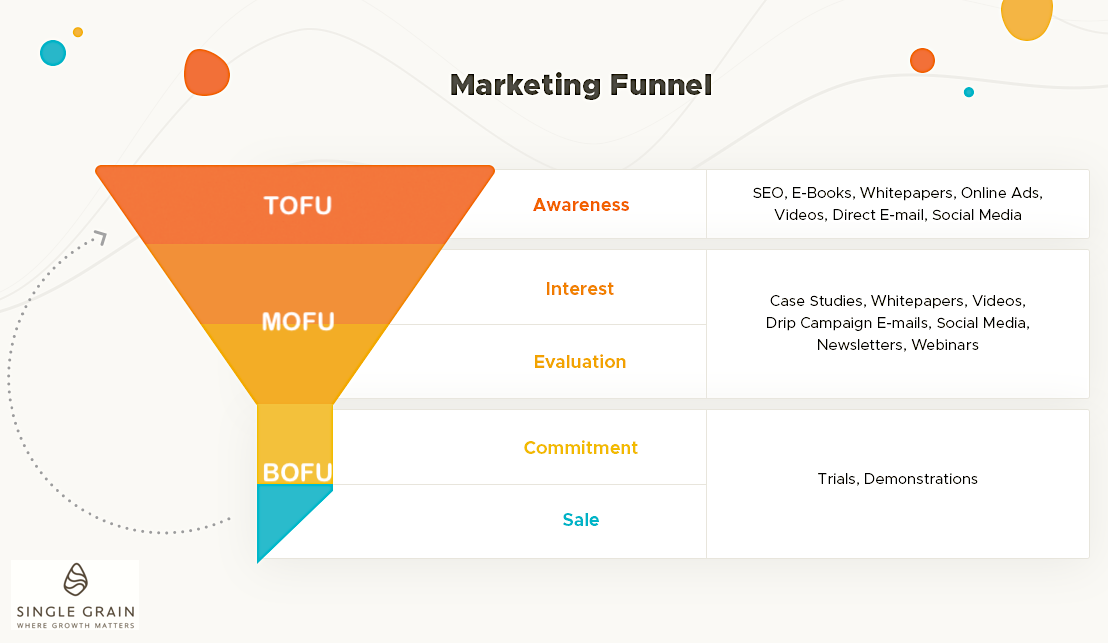
Lead nurturing should be an essential part of your strategy, and you should create different funnels to accomplish different goals (though there can be overlap in content):
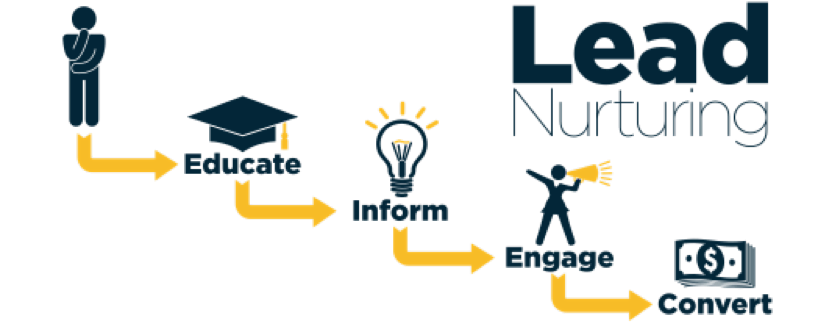
This is why it’s so important to have a distinct goal and purpose for every single blog post you write.
Let’s say you are a fitness guru. Your ultimate goal is to book more personal training clients, and your plan to do this is to gather email addresses in order to nurture leads into clients. You plan on getting these email addresses by offering a free e-book about a plant-based diet for muscle building, which will be available on your site.
You write the e-book as well as a series of posts that tie in to this lead magnet. These posts could target keywords and subjects like the following:
- What kind of diets are best for muscle building, with a section on plant-based diets
- Best practices for building muscle, which has a section on diet and can link to the above post
- Changes you can make to lead a healthier lifestyle, which could link to either of the above posts
These posts spread your net wider to catch more users who are looking for similar content under different search terms or in a different format, and since this content is all free on your site, it builds trust. It also positions you as a thought leader, to the point where users would feel comfortable trading their email address for the lead magnet.
Each post can include a mention to the e-book, but they must each have a CTA at the end of the post to download the e-book by sending users to the designated landing page. This prevents people from glossing over the link halfway through the post if they wanted to keep reading, but ensures that relevant users do make it to the landing page
You've probably seen examples of CTAs for an e-book download throughout this post – and of course we encourage you to download it! But you can also add small pop-ups, global scrolling ads or even a full-screen pop-up, depending on how aggressive you want to be – and what conversion rates you've tracked. Here's an example from our site:
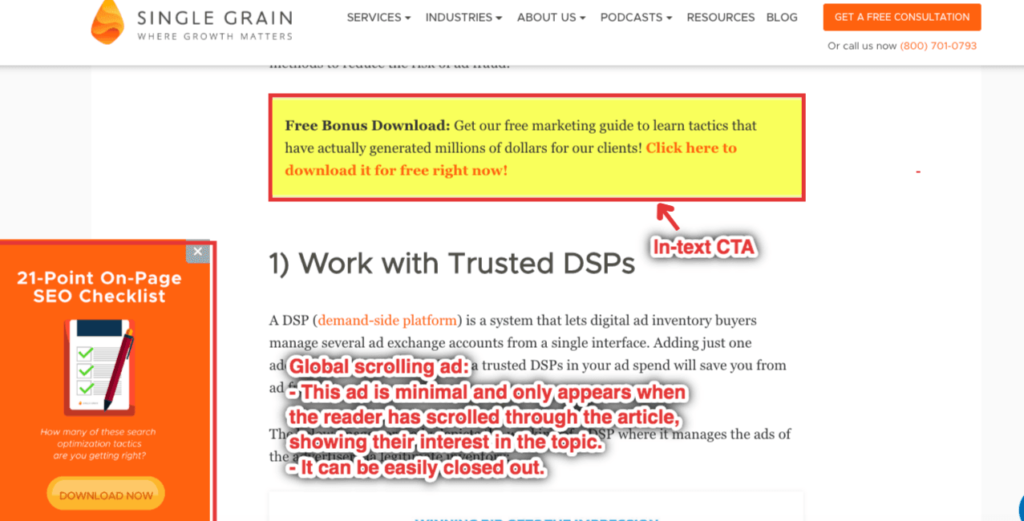
We use these CTA types because we've experimented with various pop-ups and in-text ads and found these to have higher conversion rates. But what works for our audience won’t necessarily work for yours, so A/B testing is helpful here.
Here's an example from HubSpot – the company that coined the term inbound marketing. These days HubSpot is well-established as a marketing titan, so it’s worth listening to what the experts there say:
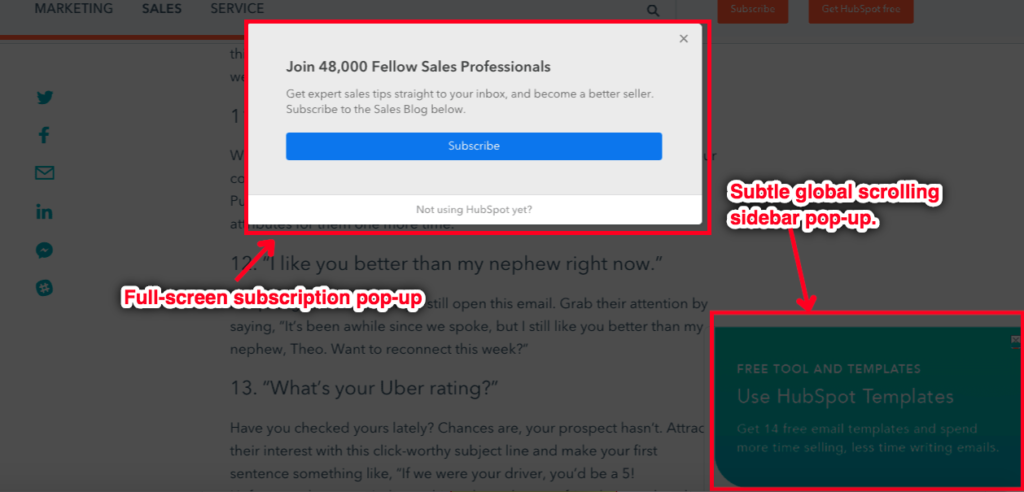
Track conversion rates in Google Analytics — setting a goal for each content download — or use a tool like Opt-In Monster, which gives you the conversion rates for each CTA.
Share your posts on social media and run ad campaigns designed to bring traffic to your site and prompt them to sign up.
Note: Remember that with GDPR guidelines, you have to include content and a checkbox to show that they've explicitly agreed to let you email them:
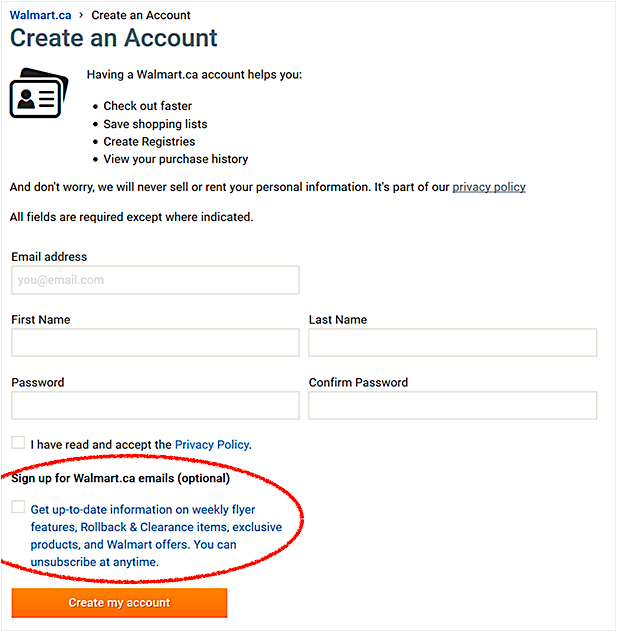
Once you’ve collected their email addresses, start sending them newsletters and lead nurturing campaigns to coax the relationship further towards your goal.
A nurturing funnel is all about the big-picture view and it will make your campaigns significantly more effective by helping you work out which pieces of content your leads should be seeing at different stages of their customer journey (as well as which types and topics of content will help move them through the funnel towards handing you their contact information).
Dive Deeper:
* What’s the Right Content for Each Stage of the Marketing Funnel?
* How to Write Lead Nurturing Content: 7 Proven Tactics
* The Types of Videos to Use at Each Stage of the Marketing Funnel
Content Marketing Distribution Plan
Distribution will technically be part of your content marketing strategy, but it’s important enough that I wanted to give it its own section. And there’s a reason for this.
Too much great content goes undiscovered online because the writer/business/marketer didn’t have a distribution plan in place. Hoping that people will find you organically through Google search is never enough, even if your site does have an incredibly high site authority and a fighting chance at top-ranking SERPs.
When it comes to content distribution, you need to be both proactive and intentional. The goal is to attract users to your landing page (ideally within your target audience), so you’ll want to get your content in front of as many eyes as possible.
Social Media
Social media is one of the most popular distribution methods out there. Your brand likely already has a built-in audience that’s engaged, so sharing posts, videos and infographics on your social channels helps to drive traffic and shares (which gets you more traffic).
Sharing your content on social platforms is the bread and butter of distribution — it should be your first port of call whenever a new post has gone live:
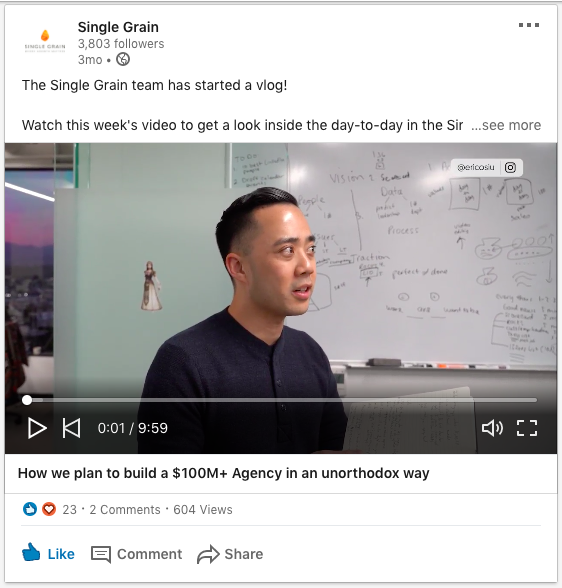
Guest Posting
Guest posting on other sites is another common strategy, though it’s slightly less in your control.
Getting your content on relevant, high-value sites gives you the opportunity to not only build your reputation and brand awareness, but also to link back to your own content. This can send interested traffic to your website and then keep visitors exploring your content for a little while.
You can share your blog posts in relevant Facebook groups and online forums, but you have to be careful with that. You don’t want to be seen as a spammer, and plenty of these venues have rules against promoting your own stuff. If someone asks a question that your recent post can address, then answer the question briefly and say “you can read more in the full post I wrote here if you’re interested” and link to it.
PPC Campaigns
If you have the budget for it, pay-per-click (PPC) campaigns are an excellent option.
You can use Google Ads to help your content climb to the top of the SERPs in relevant searches. You can also use Facebook Ads and LinkedIn Ads to put your content directly in front of your desired audience. These tools split audiences up by targeting criteria like interest, demographics or even their relationship with your business. This means you can choose who is seeing your content — and it goes without saying that this is a total game-changer for marketers, improving efficiency and making your budget work harder.
Massimo Chieruzzi from AdEspresso actually recommends using PPC campaigns to amplify inbound marketing, compounding the results by expanding their reach significantly:
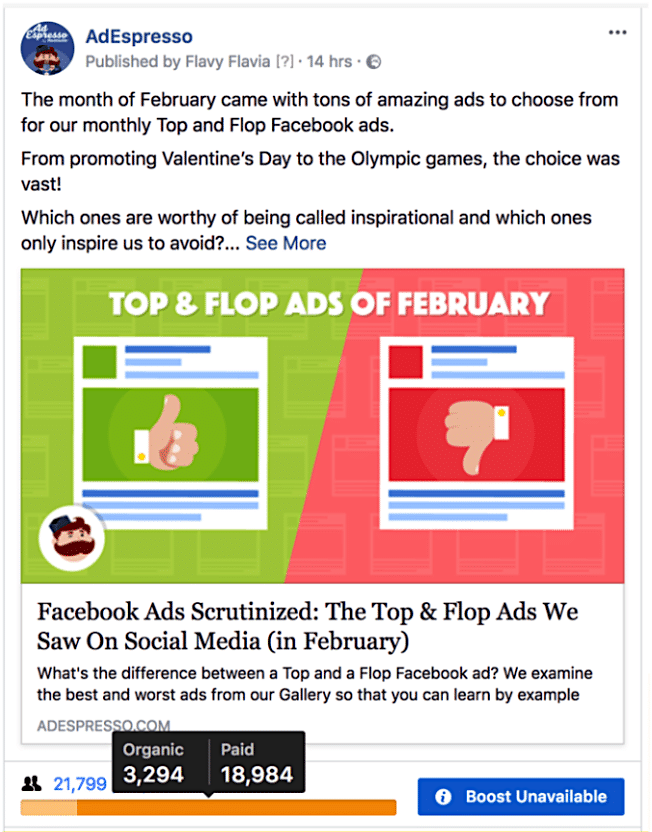
Ensuring that your plan covers multiple distribution methods will help you cover all your bases to reach the most potential readers, which is exactly what you want.
Content Marketing Tools to Streamline the Process
If content marketing feels a little overwhelming, that's because there’s a lot to keep up with! Whether you’re hiring a content manager, a team of freelancers or trying to tackle it all yourself, each of the following tools will help you streamline the process and improve your results.
Collaboration Tools like CoSchedule
I’m always excited when I hear that one of my clients uses CoSchedule:
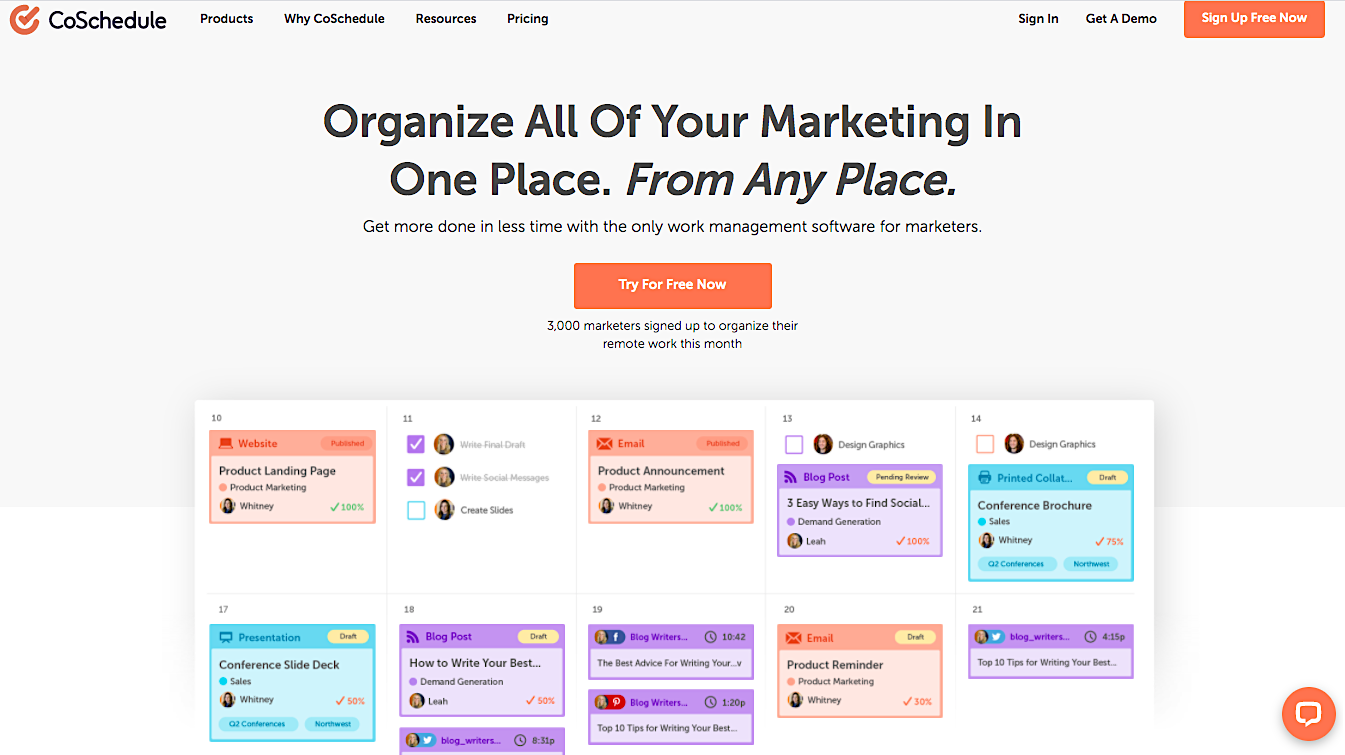
This tool allows you to actually write WordPress posts, assign authorship, add tags and categories, and even schedule social sharing all in one dashboard. They also have great analytics, which is a plus.
Other collaboration tools include:
- Slack – a godsend when a marketing team is working remotely, as it allows for easy and intuitive communication and work scheduling
- Trello – a simple yet effective project management tool
- Asana – another favorite when it comes to straightforward project management
Social Scheduling Tools like AgoraPulse and Hootsuite
Social media is often a key distribution method for most businesses using content marketing.
Both Agorapulse (whose queue feature is pictured below) and Hootsuite are my favorite tools with similar features that include in-depth analytics and publishing abilities, and both offer free trials.
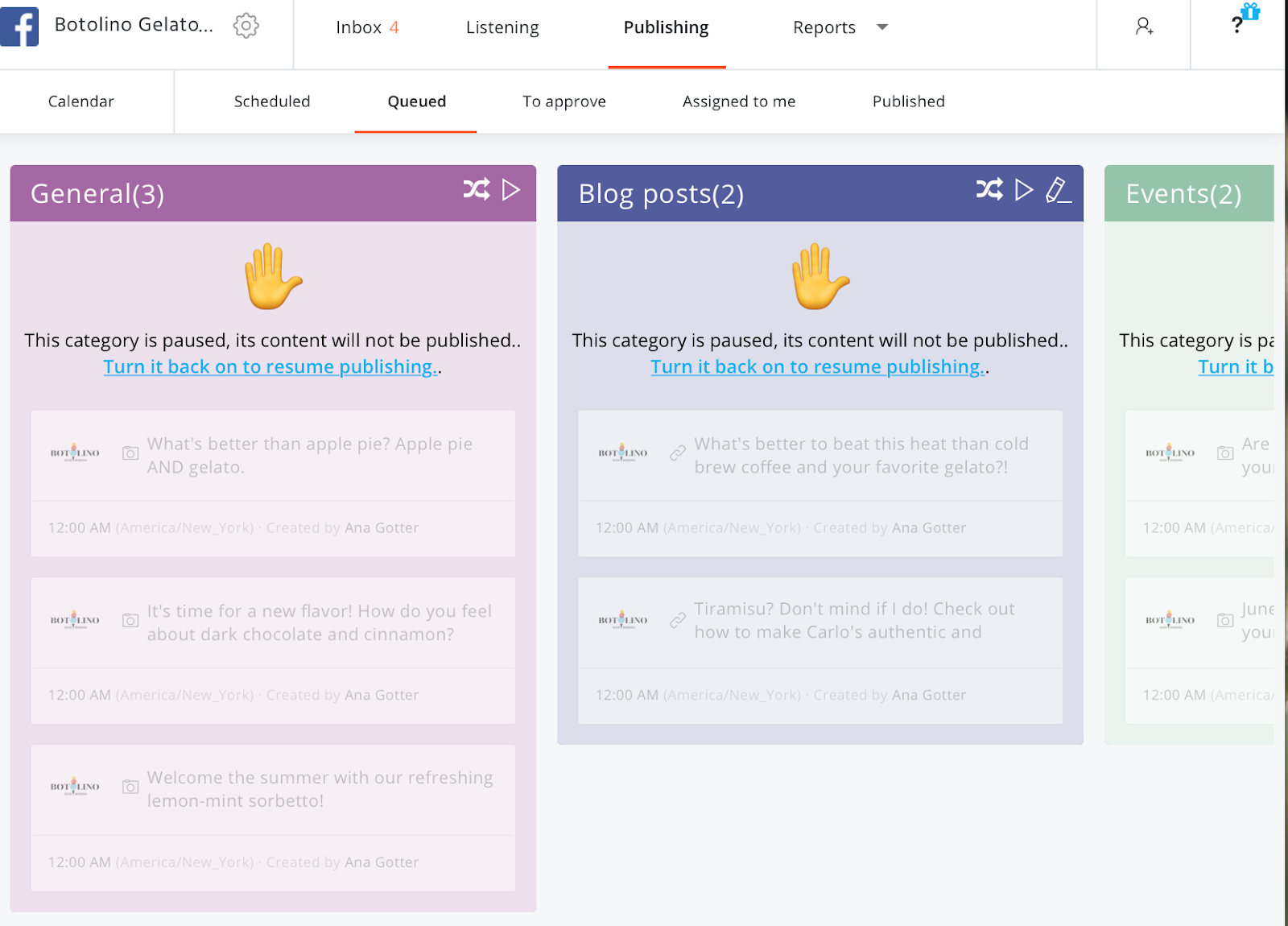
SEO Tools like the Plug-in Yoast SEO
We could all use a little help making sure that our content is SEO-friendly.
Yoast SEO is a WordPress plugin that’s easily my favorite to help me ensure that my content is readable by both humans and Google. It gives you suggestions on how to improve, which is a great benefit:
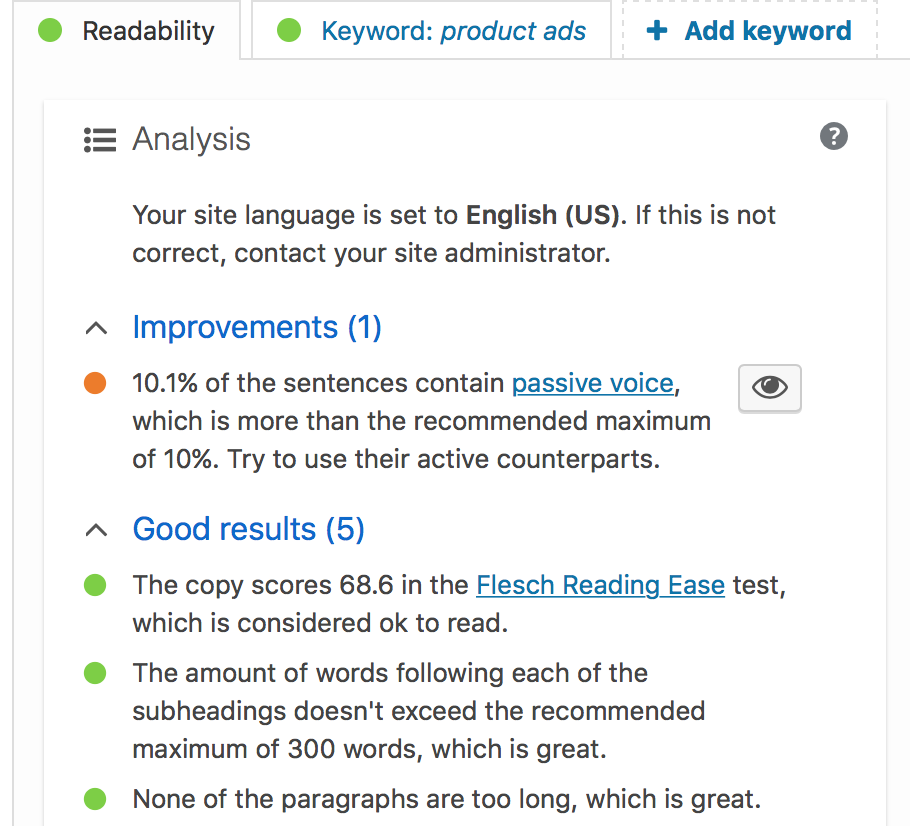
The only downside to this is that it has to be in WordPress, and a lot of people (like me) simply work in Google Docs and send completed content to clients to upload to their content management system themselves.
Meanwhile, SEO-giant Moz offers actionable SEO insights along with plenty of data so you can easily track results.
Writing Tools like Grammarly
Not everyone is a natural writer, and even if you are, it can still help to get a second set of eyes on your content. Writing tools are an easy way to help you improve your writing, including grammar and syntax.
Grammarly clearly flags any mistakes and offers word swap suggestions:
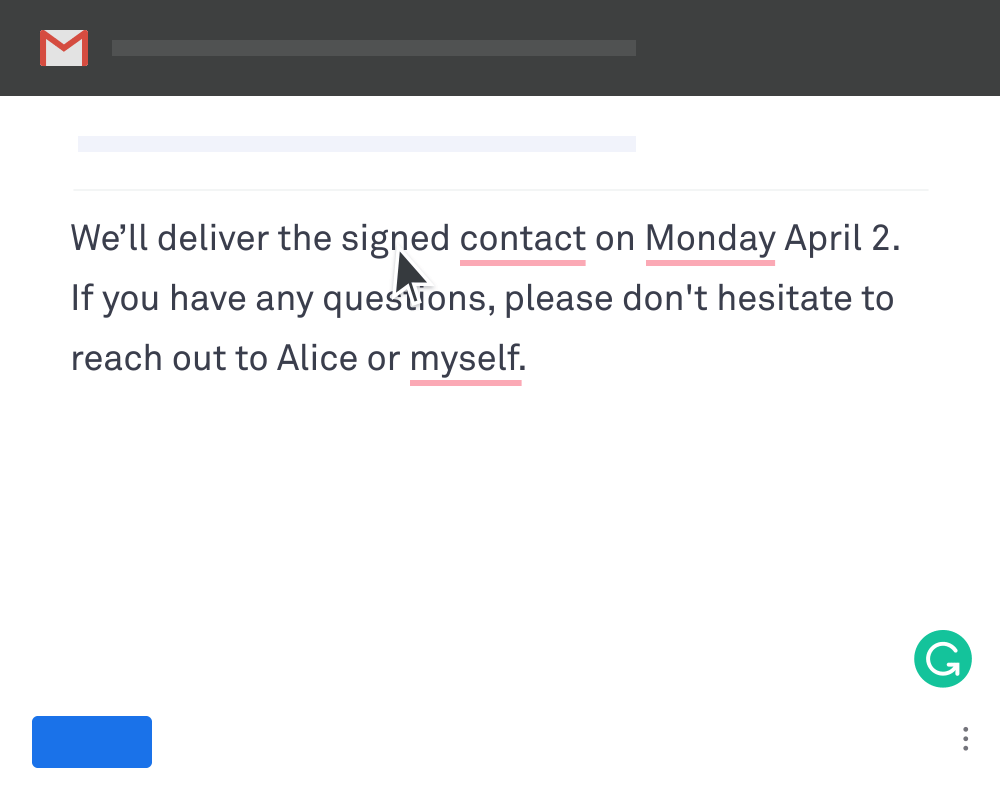
SEMrush’s SEO Writing Assistant is a mix of an SEO plugin and a writing assistant, and it will review your content for overall readability and SEO-friendliness even when you're writing in Google Docs:
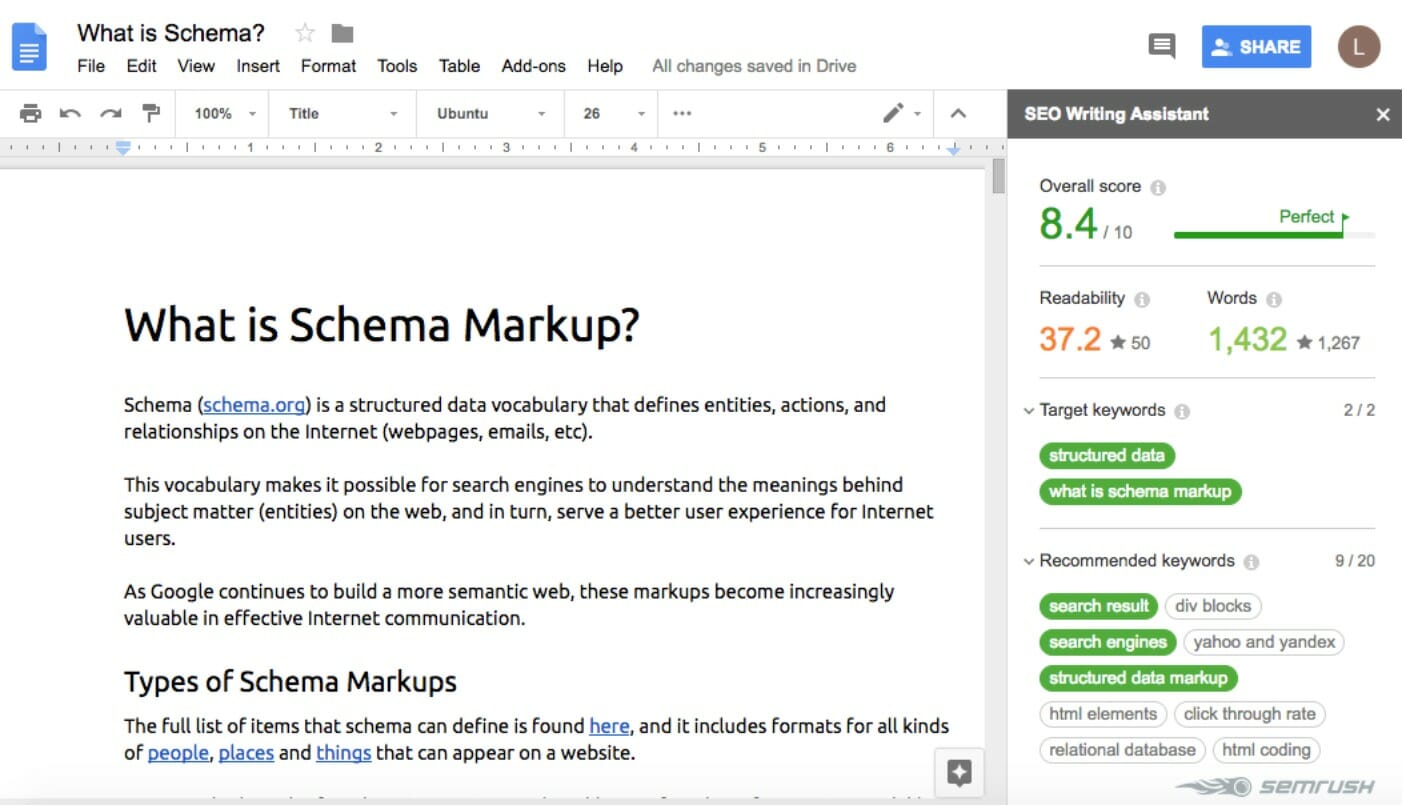
Dive Deeper:
* 30 Ways to Come Up with Great Ideas for Your Blog Posts
* 7 SEO Copywriting Tips to Increase Your Rankings in 2020
* 9 Tips to Take Your Blog Content from Average to Awesome
Content Marketing Mistakes to Avoid
We’ve covered pretty much everything that you should do to ensure a successful content marketing strategy. Now, almost as importantly, let’s take a look at what not to do.
Some of the biggest content marketing mistakes you can make are:
- Not posting frequently. Readers will notice when you're not consistently posting content and this can harm trust and brand authority. Obviously the number of blog posts you publish will vary from brand to brand, so you'll have to play around to find your own ideal schedule, but here's what HubSpot suggests:
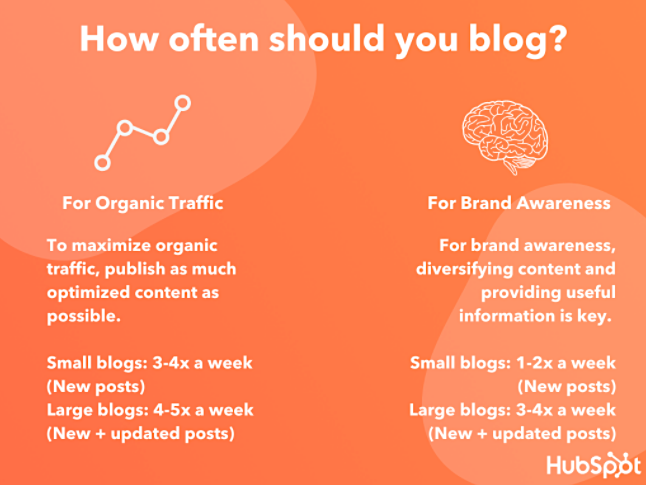
- Not defining your tone of voice. Articulating your brand's voice should be done in part based on who you are and in part based on audience research. Once you've determined it, add that to your content process document and use this to train all brand writers and customer-facing teams so that your content is consistent. If you're a law firm, your voice might be professional and authoritative, with a good dose of industry-specific jargon. If you're a funky startup, your voice could be more casual and even humorous. It all depends on what your audience is going to engage with best.
- Relying exclusively on SEO as a distribution method. This may be the biggest mistake I see in the content marketing world. People create content and then think that SEO is all that’s needed to get traffic to their site. Instead, use other distribution methods like emailing your subscriber base, social sharing, paid social or PPC ad campaigns. This is particularly important at first, when your site authority will be lower and you need all the extra help you can get.
- Not choosing strategic goals for each individual post. You may have just one goal for your content, or you may have four or five goals. That’s fine, but each individual blog post should be written with one specific goal in mind. Each post should be written with lead generation or product promotion or on-site engagement in mind. Remember — if you try to do too much, readers will get overwhelmed and not convert on anything.
- Forgetting to link to your own content. I recommend that each blog post contain 3-5 internal links to your own content and/or product pages. This keeps people bouncing around on your own site instead of bouncing off of it. It also makes it easier to establish relationships with readers long-term, and has SEO benefits.
- Forgetting to link to other people’s content. Sending users to other sites may seem counterintuitive, but it has several distinct benefits. It’s a good SEO move, it shows users that you can back up your statements with legitimate sources, and it can even foster positive relationships with other industry influencers.
- Ignoring advances in automation. There are so many automation tools out there that can boost the power of your marketing team and allow you to massively scale up without the need to expand your team. Email automation tools are a big one here.
Each of these mistakes can be exceptionally detrimental to your overall results and the effectiveness of your campaigns, so avoid them at all costs!
Final Word on Content Strategy
Content marketing is now a non-negotiable part of running a business, and it’s getting more sophisticated by the day. Bringing together audience research, business goals and analytics results into a multimedia strategy aligned with your brand's unique voice and targeted to different audience segments at different stages of the nurturing funnel is no easy job.
But the best chance you have of nailing it is making sure you know your audience inside and out, following best content creation and distribution practices, and ensuring that all your processes are written down and followed to the letter.
Do this and you’ll start to see improvements in traffic, engagement and conversion, which you can build on for true content marketing success!
The post How to Create a High-Performance Content Marketing Strategy in 2020 appeared first on Single Grain.
from Single Grain https://ift.tt/2YwjjGV

No comments:
Post a Comment